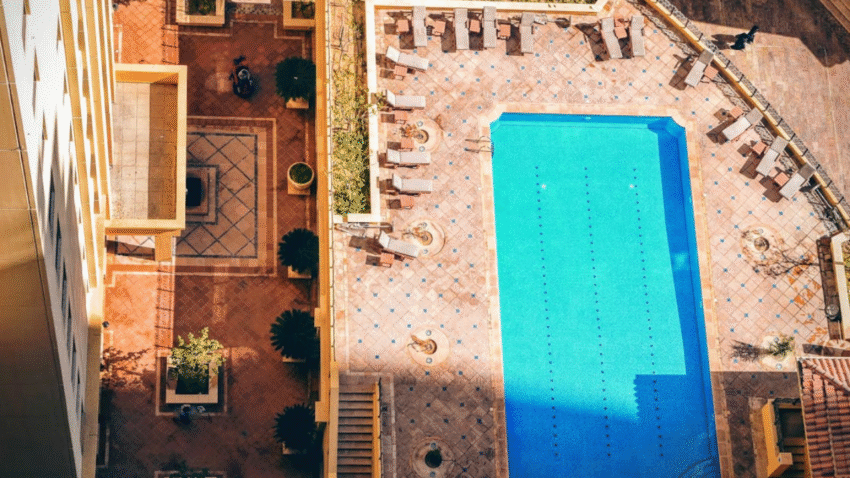Introduction
Thinking about draining your pool to clean it? Think again. Draining a pool isn’t just time-consuming — it can also damage your pool’s structure if not done properly. In this guide, you’ll learn how to clean a pool without draining it, using safe and effective methods to restore clarity, balance, and hygiene without emptying a single gallon. Whether your pool is cloudy, stained, or full of debris, these steps will bring it back to life.
Why Cleaning Without Draining Matters
Draining a pool can weaken the walls, unbalance the structure, and even cause your inground pool to lift from hydrostatic pressure. More importantly, it wastes thousands of gallons of water and disrupts your pool’s chemical stability.
Regular cleaning without draining:
- Maintains pH and chlorine balance
- Prevents algae and staining
- Saves water, time, and money
- Extends the life of your liner, plaster, or tiles
Learning how to clean your pool while it’s full is essential for year-round maintenance and pool safety.
Step-by-Step Guide to Cleaning a Pool Without Draining It
Step 1: Remove Surface Debris
Start with a leaf skimmer or pool net to clear leaves, bugs, and other floating debris. Do this daily during heavy use or after storms. Surface debris not only looks bad, but also breaks down into organic matter that feeds algae.
💡 Tip: A leaf rake attachment is great for scooping debris from the pool floor.
Step 2: Brush the Walls and Floor
Use a pool brush to scrub the walls, steps, corners, and floor. Focus on areas with discoloration, biofilm, or algae growth. Brushing loosens particles and sends them into the water column for filtration.
- Use a nylon brush for vinyl or fiberglass pools
- Use a stainless steel brush for concrete or plaster pools
⚠️ Caution: Never use a metal brush on soft-sided pools to avoid damage.
Step 3: Manually Vacuum the Pool
After brushing, let particles settle for a few hours, then vacuum. Use a manual pool vacuum or an automatic pool cleaner to remove fine debris and sediment from the floor.
💡 Pool Owner Tip: Set your filter to “waste” when vacuuming if dealing with excessive debris or algae, and refill the pool as needed.
Step 4: Clean or Backwash Your Filter
Your filter system is your biggest ally when cleaning without draining. Make sure it’s running efficiently:
- Cartridge filter: Rinse the cartridge thoroughly
- Sand filter: Perform a backwash
- DE filter: Backwash and recharge with DE powder
Clean filters trap contaminants and restore water clarity faster.
Step 5: Test and Balance the Water
Use a pool water testing kit to check the following:
- Chlorine (1–3 ppm)
- pH (7.2–7.6)
- Alkalinity (80–120 ppm)
- Cyanuric Acid (30–50 ppm for outdoor pools)
- Calcium Hardness (200–400 ppm)
Unbalanced water can cause scaling, corrosion, or cloudy water — and reduces the effectiveness of sanitizers.
Step 6: Shock the Pool
“Shocking” means adding a high dose of chlorine to kill algae, bacteria, and organic matter.
- Use calcium hypochlorite or non-chlorine shock depending on your needs
- Shock the pool at night to prevent UV burn-off
- Keep the pump running for 8–12 hours
💡 Tip: After shocking, brush the pool again to remove dead algae and circulate chemicals.
Step 7: Use a Clarifier or Flocculant
If the water is still cloudy, add a pool water clarifier to bind small particles into filterable clumps. For heavier issues, a flocculant will sink debris to the bottom, making it easier to vacuum out.
- Clarifier: Add and run pump normally
- Flocculant: Add, let settle overnight, and then vacuum to waste
Step 8: Clean Tile Lines and Skimmer
Scrub the waterline tiles using a non-abrasive pool tile cleaner to remove scum, oils, and calcium deposits. Clean the skimmer basket and check the pump basket for blockages as well.
Common Mistakes to Avoid
- Overlooking Water Testing
Cleaning the pool without checking chemistry is ineffective. Always test and balance water during cleaning. - Using Household Cleaners
These can alter water chemistry and cause foaming. Only use pool-safe cleaning products. - Ignoring Filter Maintenance
A dirty or clogged filter can’t keep up with cleaning. Clean or backwash it before and after major cleanings. - Not Running the Pump Long Enough
Short filtration cycles lead to poor water circulation. After a deep clean, run the pump continuously for 24 hours. - Skipping Regular Maintenance
Waiting until the pool is dirty creates more work. Clean weekly to prevent buildup.
Extra Tips & Pool Hacks
- Add Enzymes Weekly: Enzyme-based pool treatments help break down oils, lotion, and organic matter.
- Try a Pool Slime Bag: Attach this to your return line for extra fine particle filtration.
- Shock Weekly During Summer: Keeps your water fresh and free of invisible contaminants.
Need more help balancing your water? Check out our full guide on [how to test and balance pool chemicals].
Conclusion
Cleaning a pool without draining it is not only possible — it’s the best way to maintain your pool safely and efficiently. With regular brushing, vacuuming, chemical balancing, and filter maintenance, your pool will stay crystal clear without the risks or cost of draining.
📌 Bookmark this guide for your next deep clean!
